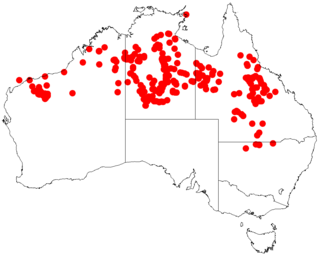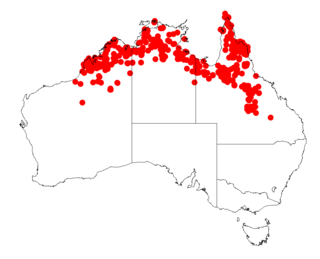
Acacia aneura, commonly known as mulga or true mulga, is a shrub or small tree native to arid outback areas of Australia. It is the dominant tree in the habitat to which it gives its name (mulga) that occurs across much of inland Australia. Specific regions have been designated the Western Australian mulga shrublands in Western Australia and Mulga Lands in Queensland.

Acacia pulchella, commonly known as prickly moses or western prickly moses, is a shrub in the family Fabaceae. Endemic to Western Australia, it is one of the most common shrubs of the bushland around Perth and in the Darling Range.

Acacia kempeana, commonly known as wanderrie wattle, witchetty bush or granite wattle, is a shrub in subfamily Mimosoideae of family Fabaceae that is endemic to arid parts of central and western Australia.

The Avon Wheatbelt is an Australian bioregion in Western Australia. It has an area of 9,517,104 hectares. It is considered part of the larger Southwest Australia savanna ecoregion.

Acacia didyma is a shrub or small tree which is native to Western Australia. It grows to between 1.5 metres and 4 metres in height and flowers from August to October in its native range.

Acacia myrtifolia, known colloquially as myrtle wattle, red stem wattle or red-stemmed wattle, is a species of Acacia native to coastal areas of southern and eastern Australia.

Acacia holosericea is a shrub native to tropical and inland northern Australia. It is commonly known as soapbush wattle, soapbush, strap wattle, candelabra wattle, silver wattle and silky wattle.

Acacia mitchellii, commonly known as Mitchell's wattle, is an erect or spreading shrub which is endemic to Australia. It grows to up to 2 metres high and has small bipinnate leaves. The pale yellow globular flowerheads appear in groups of 1 to 3 in the axils of the phyllodes followed by straight or curved seed pods which are 1.8 to 5 cm long and 4 to 8 mm wide.

Acacia cowleana, Halls Creek wattle, is a northern Australian native shrub. It is a flowering plant with yellow flowers that only open in winter. Its origin is the Northern Australia's dry tropics. It belongs to the genus of Acacia.

Acacia demissa is a species of Acacia native to an area of Western Australia inland of Shark Bay. It grows as a shrub or small tree, reaching 1.5–4 metres tall. It is closely related to A. quadrimarginea, with which it may hybridise.

Acacia platycarpa, commonly known as the pindan wattle or ghost wattle, is a species of plant in the legume family that is native to northern Australia from Western Australia through the Northern Territory to Queensland.
Persoonia bowgada is a species of flowering plant in the family Proteaceae and is endemic to the south-west of Western Australia. It is an erect to spreading shrub with smooth bark, more or less cylindrical leaves and yellow flowers in groups of up to ten on the ends of branches.

Acacia ataxiphylla, commonly known as the Large-fruited Tammin wattle, is a shrub belonging to the genus Acacia. It is native to Western Australia.

Acacia ramulosa, commonly known as horse mulga or bowgada wattle, is a shrub belonging to the genus Acacia and the subgenus Juliflorae endemic to arid areas of Australia.

Acacia crassuloides is a shrub belonging to the genus Acacia and the subgenus Phyllodineae. It is native to an area in the Goldfields-Esperance and Wheatbelt regions of Western Australia.

Acacia abrupta is a shrub of the genus Acacia and the subgenus Plurinerves that is endemic to arid parts of central and western Australia.

Acacia ancistrophylla is a shrub of the genus Acacia and the subgenus Plurinerves that is native to several areas on southern Australia.

Acacia subracemosa, also known as western karri wattle, is a shrub of the genus Acacia and the subgenus Pulchellae that is endemic to a small area of south western Australia
Grevillea phanerophlebia, commonly known as the prominent vein grevillea and the vein leaf grevillea, is a shrub of the genus Grevillea native to a small area on the west coast in the Mid West region of Western Australia.
Grevillea rara, also known as the rare grevillea, is a shrub of the genus Grevillea native to a small area in the South West region of Western Australia.

















